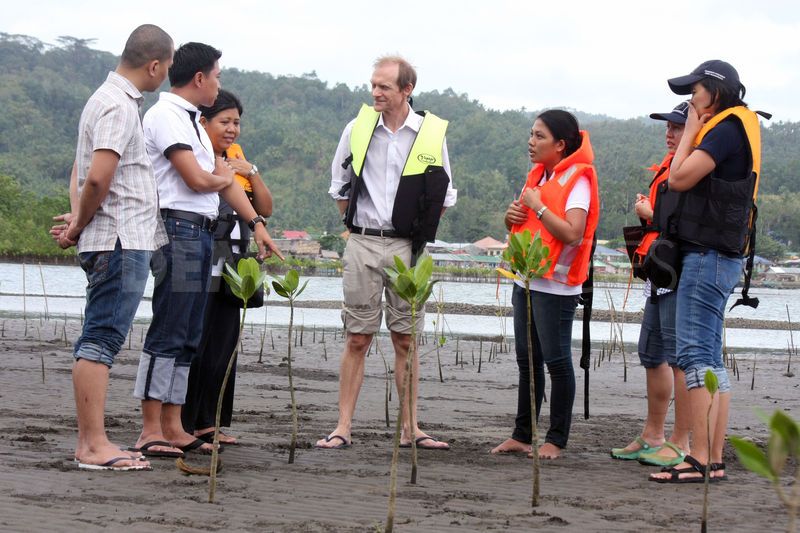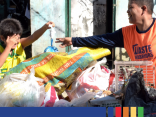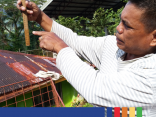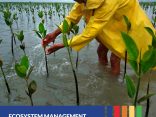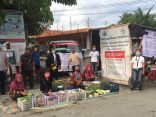When a 7.6-magnitude quake hit the Visayas and triggered a tsunami warning in the Pacific coast a month ago, some 7,000 residents from coastal barangays here evacuated to higher ground within 12 minutes.
(Photo credit to Gregorio Dantes Jr.)
(This report was first published in print in issue the Philippine Daily Iquirer on 30 September 2012. Web version is available in this link.)
By Tarra Quismundo
Philippine Daily Inquirer
ST. BERNARD, Southern Leyte—When a 7.6-magnitude quake hit the Visayas and triggered a tsunami warning in the Pacific coast a month ago, some 7,000 residents from coastal barangays here evacuated to higher ground within 12 minutes.
In the fast and orderly retreat to safer ground, everyone was spared from harm.
Scarred by a deadly landslide six years ago, this fourth-class town of 27,000 residents has emerged as a “flagship” example in disaster preparedness, response and mitigation, its early warning system and community-based readiness program now a model for other vulnerable towns to emulate.
“Where we fall, we will rise,” said town Mayor Rico Rentuza in opening the national disaster risk reduction and climate change conference here on Friday.
“We are not a rich town, but we are rich in hazards. Name all the hazards, we have them … We want to build a culture of preparedness. With all the things we implemented in St. Bernard, we are already experiencing the impact of more efficient emergency response and coordination,” Rentuza said before an audience of fellow government officials and civil society groups that gathered to learn about his town’s experience.
Once rendered “helpless” by a landslide that killed more than 1,000 residents in 2006, this town of survivors has integrated disaster risk reduction into their daily lives.
Early warning systems
Barangays on the town’s Pacific coast man state-of-the-art early warning systems round-the-clock, ready to immediately dispatch alerts through loudspeakers installed in hazard-prone villages. All around town are disaster preparedness posters and signs. Evacuation routes are marked.
Volunteers plant mangroves along the coastline to build a natural shield from flooding. Young people regularly go to disaster-preparedness camps. And the town government, supported by both local and international agencies, is in a constant state of readiness—that is, ready to sustain the program even when left to stand on their own feet.
“As a first-time visitor in Southern Leyte, it is rewarding to see how St. Bernard has been fully involved in community-based disaster risk reduction projects since the results of its investment are manifested in the successful outcomes of drills and actual evacuation,” said European Union Manila head of delegation Guy Ledoux, addressing the forum.
“I would say that regarding disaster preparedness, St. Bernard is certainly the flagship. It is the most successful project and we are now [looking] to share the success in disaster preparedness of St. Bernard,” an impressed Ledoux later said in an interview.
He also noted how the Philippines has come a long way in disaster risk reduction efforts compared to its neighbors in the region.
“We are proud to recognize that the Philippines is ahead of its Southeast Asian neighbors as it has adopted a policy framework on disaster preparedness and local government units have been trained in implementing this framework,” Ledoux said.
Int’l assistance
Through a modest P10-million assistance over five years, the European Union and other partner agencies, including CARE Netherlands and the German Agency for International Cooperation (GIZ), have helped build the town’s capacity for disaster risk reduction.
International funding helped the town create its local disaster risk reduction office, which maintains a sophisticated, Filipino-made early warning system in eight high-risk barangays.
Designed and operated by Filipino scientist Reginald Juan Mercado, devices that detect multiple hazards such as flood, earthquake, landslide and tsunami, among others, are hooked to barangay stations that could readily issue warnings through loudspeakers whenever necessary.
While monitored by a nerve-center based at the town hall, this decentralized system makes for faster dispatch of information, Rentuza said. “They don’t have to wait for me to issue the warning,” he said.
Colorful houses
The town has also designated evacuation sites in every sector. This way, residents already know where to run when the emergency comes.
Incidentally, one such site is the uphill resettlement site for survivors of the Guinsaugon landslide. Permanently relocated after the 2006 landslide, some 286 families (1,023 people) now reside in the new village, living in colorful concrete homes built by the Red Cross, Gawad Kalinga and the Japan International Cooperation Agency.
“I am proud to say that from tragedy, we are now host to evacuees from Barangay Tambis Uno,” said New Guinsaugon village chief Beauty Omela Cabacungan, referring to one of the town’s vulnerable barangays.
“Our secret to still surviving is our faith in God and the prayer that whatever problem happens, we offer it to God, for we all know that God will provide,” said Cabacungan in welcoming Ledoux and other visiting officials to her village on Friday.
Mangrove propagation
The town also has a mangrove propagation program in three barangays to mitigate the impact of annual flooding. Manned by volunteers, the program aims to plant some 7.2 hectares of coastal land with mangroves like bakawan and piyapi to create a natural barrier from storm surges and flooding.
Five years since implementing the program, volunteers notice that prawns and small crabs have started to inhabit the mangrove area.
Ruperto Rafols, a barangay chief and volunteer at the mangrove nursery, said the presence of mangroves has helped ease flooding levels in coastal barangays and also curbed soil erosion. Mangroves have also encouraged prawns and crabs to inhabit the area.
All such initiatives are “replicable” for other vulnerable towns to also implement, noted Ledoux, citing how St. Bernard has maximized its P3-million annual allocation—5 percent of the town’s total budget—for disaster risk reduction efforts.
Lifelong process
“The St. Bernard experience is a good example of how local communities with the support of civil society organizations and collaboration with local government authorities can spearhead collective action along disaster risk reduction,” Ledoux said.
Much needs to be done, conceded Rentuza, as he gave assurance that the local government will not waver in disaster risk reduction efforts.
“There is still much to be done. And it requires commitment, focus, time … We have a long way to go. This should be a lifelong process and practice,” Rentuza said.
The European Union has been a steady humanitarian partner of the Philippines as part of its global effort to provide financial and technical aid to disaster-prone countries. Between this year and 2013, the EU has allocated P130 million for disaster-preparedness initiatives across the Philippines.
(Photo credit to Gregorio Dantes Jr.)

